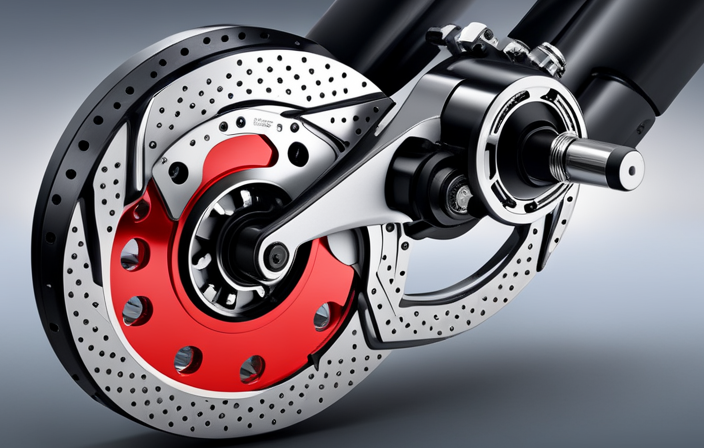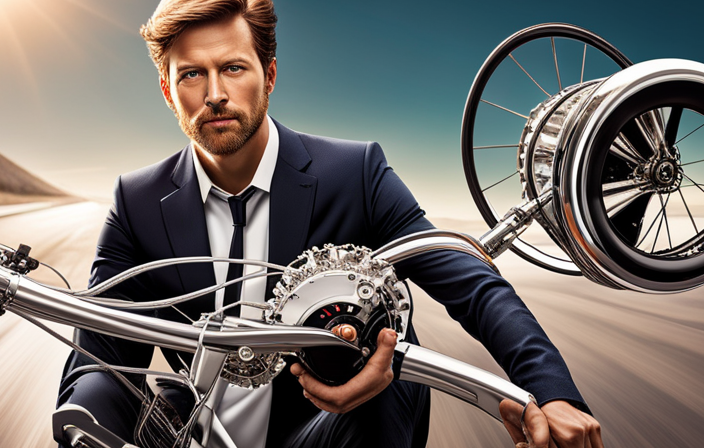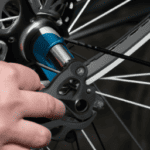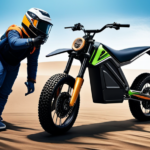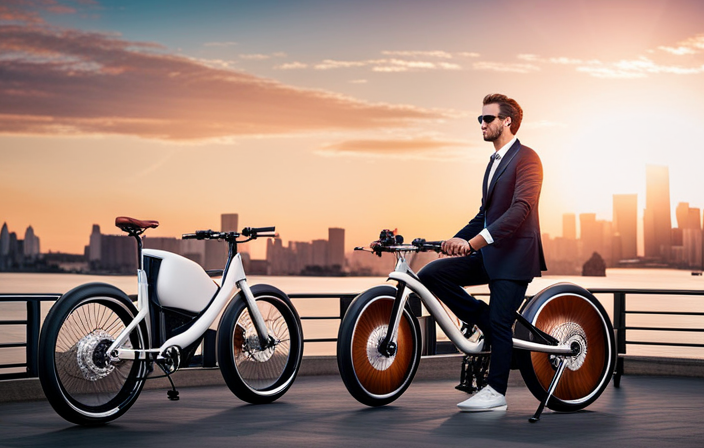As I glide along the city streets on my electric bike, I can’t help but marvel at the technology that keeps me safe and in control – the braking system.
In this article, we will explore the intricate workings of electric bike brakes and how they ensure a smooth and controlled riding experience.
From mechanical disc brakes to hydraulic systems, we will delve into the technical details, benefits, and safety tips to help you better understand and appreciate the importance of this crucial component.
So, let’s dive in and uncover the fascinating world of electric bike brakes.
Key Takeaways
- Electric bike brakes are crucial for safety and control while riding.
- There are two main types of electric bike braking systems: mechanical disc brakes and hydraulic disc brakes.
- Mechanical disc brakes work by using brake calipers, pads, levers, and cables to stop the bike.
- Hydraulic disc brakes function through a hydraulic braking system that uses a master cylinder and fluid transmission to squeeze the brake pads against the rotor.
Importance of Braking Systems in Electric Bikes
You need to understand the importance of braking systems in electric bikes. Properly functioning brakes are essential for the safety and control of the rider. Without a reliable braking system, the risk of accidents and injuries increases significantly.
To ensure the longevity and optimal performance of your electric bike brakes, regular maintenance is crucial. This includes checking the brake pads for wear and tear, inspecting the brake cables for any signs of damage, and lubricating the brake levers and calipers.
Additionally, troubleshooting techniques such as adjusting the brake tension and aligning the brake pads can help resolve common issues like squeaking or inconsistent braking.
By following these maintenance tips and troubleshooting techniques, you can keep your electric bike brakes in top condition.
Now, let’s move on to an overview of electric bike braking systems.
Overview of Electric Bike Braking Systems
To get a sense of how electric bike brakes function, it’s important to understand the different types of braking systems available. Electric bikes typically use two main types of braking systems: mechanical disc brakes and hydraulic disc brakes.
Proper maintenance is crucial for the longevity and effectiveness of electric bike brakes. Regular inspections and adjustments can help prevent issues such as brake pad wear, misalignment, and reduced braking power. One important aspect of maintenance is checking and adjusting the brake pad position. This involves ensuring that the brake pads are properly aligned with the disc rotor, as misalignment can lead to uneven braking and premature wear.
To adjust the brake pad position, start by loosening the bolts that secure the brake caliper. Then, position the pads so they are evenly aligned with the rotor. Finally, tighten the bolts to secure the caliper in place.
Understanding the importance of proper maintenance and knowing how to adjust brake pad position are essential for maximizing the performance and safety of electric bike braking systems.
Moving on to the next section about how mechanical disc brakes work…
How Mechanical Disc Brakes Work
When it comes to mechanical disc brakes on electric bikes, there are two key components that play a crucial role in the braking system: brake calipers and pads, and brake levers and cables.
The brake calipers, which are attached to the frame of the bike, house the brake pads and are responsible for squeezing them against the rotor to create friction and slow down the bike.
The brake levers, on the other hand, are the control mechanism that the rider uses to activate the brakes, and they are connected to the brake calipers by a series of cables that transmit the force from the lever to the calipers.
Brake Calipers and Pads
Simply squeeze the brake lever on your electric bike, and the brake calipers will clamp down on the brake pads, creating friction to slow down or stop the bike.
Brake calipers are the mechanical devices responsible for this action. They are usually mounted on the front and rear wheels and are connected to the brake levers through cables.
Brake caliper adjustment is necessary to ensure optimal brake performance. This can involve adjusting the position of the caliper, aligning it with the brake rotor, and tightening or loosening the mounting bolts.
Over time, brake pads wear out and need replacement. They are attached to the calipers and provide the necessary friction to stop the bike.
Once the brake calipers and pads are properly set up, the next step is understanding the role of brake levers and cables in the braking process.
Brake Levers and Cables
The brake levers and cables on an electric bike are responsible for transmitting the force from the rider’s hand to the brake calipers, activating the braking system. The brake levers are located on the handlebars and are squeezed by the rider’s fingers to apply pressure to the brake cables. These cables, made of steel or other durable material, are connected to the brake calipers. When the brake levers are squeezed, the force is transferred through the cables to the calipers, causing the brake pads to clamp down on the brake rotor or wheel rim, depending on the type of brakes. To ensure optimal braking performance, it is important to periodically adjust the brake lever position and cable tension. This can be done by using the appropriate tools to fine-tune the position and tension of the brake cables. By making these adjustments, the rider can maintain responsive and reliable braking. Moving forward, let’s explore how hydraulic disc brakes work.
| Brake Lever Adjustment | Cable Tension Adjustment |
|---|---|
| 1. Locate adjustment screw on brake lever | 3. Loosen or tighten the barrel adjuster on the brake cable |
| 2. Use a screwdriver to turn the adjustment screw | 4. Test the brake lever to ensure proper tension |
| 3. Adjust the lever position to your preference | 5. Repeat as needed to achieve desired tension |
Now, let’s delve into the workings of hydraulic disc brakes.
How Hydraulic Disc Brakes Work
To understand how hydraulic disc brakes work on an electric bike, you can visualize a closed hydraulic system that uses fluid to transmit force and apply pressure on the brake pads.
The hydraulic brake components consist of a master cylinder, hydraulic lines, calipers, and pistons. When the rider squeezes the brake lever, it activates the master cylinder, which pushes the brake fluid through the hydraulic lines and into the calipers.
The fluid then pushes the pistons, which in turn squeeze the brake pads against the rotor, generating friction and slowing down the bike. The brake fluid used in hydraulic disc brakes is specially formulated to have high boiling points and resist compressibility, ensuring consistent and reliable braking performance.
Hydraulic disc brakes offer several benefits, such as better stopping power, improved modulation, and reduced maintenance compared to mechanical disc brakes. However, they can be more expensive and require more technical expertise for installation and maintenance.
Benefits and Drawbacks of Mechanical Disc Brakes
One of the advantages of mechanical disc brakes is that they are generally more affordable and easier to install and maintain compared to hydraulic disc brakes. This makes them a popular choice among electric bike riders who are looking for a cost-effective braking solution.
Mechanical disc brakes work by using a cable to pull on a lever, which then applies pressure to the brake pads, causing them to squeeze against the rotor. This design allows for reliable stopping power and modulation, giving riders better control over their speed.
However, there are some disadvantages to mechanical disc brakes. They require more force to engage and may not provide as much stopping power as hydraulic disc brakes. Additionally, mechanical disc brakes are more prone to wear and may require more frequent adjustments.
Despite these drawbacks, mechanical disc brakes are still a viable option for many electric bike riders.
Moving on to the benefits and drawbacks of hydraulic disc brakes…
Benefits and Drawbacks of Hydraulic Disc Brakes
Hydraulic disc brakes offer improved stopping power and modulation compared to their mechanical counterparts. With hydraulic disc brakes, stopping power is enhanced through the use of hydraulic fluid rather than a cable system. This allows for more precise control over the amount of force applied to the brake rotor. Additionally, hydraulic brakes require less hand force to operate, making them easier to use and reducing fatigue during long rides.
One of the benefits of hydraulic disc brakes is the ability to upgrade disc rotors. Different disc rotors can be installed depending on the specific riding conditions, such as wet or muddy terrain. This allows for optimal braking performance in various situations.
Furthermore, hydraulic disc brakes offer the advantage of adjusting hydraulic brake pressure. This means that riders can fine-tune the brake system to their preferences. Whether they prefer a more aggressive or a more gradual braking feel, the hydraulic brake pressure can be adjusted accordingly.
Moving forward to the subsequent section about ‘how regenerative braking works’, it is important to understand the different brake systems available for electric bikes.
How Regenerative Braking Works
When it comes to regenerative braking, it’s all about the ability to capture energy during braking and convert it into electrical energy.
This process allows for the conversion of the kinetic energy generated during braking into a usable form that can be stored and used later.
By harnessing this energy, electric bikes are able to increase their overall efficiency and extend their range, making them a more sustainable and practical mode of transportation.
Capturing Energy during Braking
To capture energy during braking on an electric bike, you can use regenerative brakes which convert the kinetic energy into electrical energy. This process involves several steps:
- The regenerative braking system detects when the rider applies the brakes.
- The system engages a generator or motor, which acts as a generator during braking.
- As the bike slows down, the kinetic energy is converted into electrical energy by the generator.
- The electrical energy is then stored in the bike’s battery for later use.
By capturing and converting power during braking, electric bikes can increase their overall efficiency and range. This regenerative braking technology allows the bike to take advantage of the energy that would otherwise be lost during braking, making it a more sustainable and eco-friendly transportation option.
Moving on to the next section, this energy can be further utilized by converting the kinetic energy into electrical energy.
Converting Kinetic Energy into Electrical Energy
By capturing and converting power during braking, electric bikes can increase their overall efficiency and range, which can be further enhanced by converting the kinetic energy into electrical energy. This process, known as regenerative braking, allows electric bikes to recover and store energy that would otherwise be lost as heat during braking. When the rider applies the brakes, the electric motor switches into generator mode, using the rotation of the wheels to generate electricity. This electrical energy is then stored in the battery for later use. To achieve this, electric bikes are equipped with a regenerative braking system that includes sensors, a controller, and a battery. The sensors detect when the rider applies the brakes and send a signal to the controller, which activates the generator mode in the motor. The converted kinetic energy is then transferred to the battery, where it is stored until needed. This innovative technology not only improves the efficiency of electric bikes but also extends their range, making them a more sustainable and practical transportation option. Moving on to the next section, let’s explore the advantages and limitations of regenerative braking.
Advantages and Limitations of Regenerative Braking
You can take advantage of regenerative braking on electric bikes as a way to recharge the battery while slowing down. This innovative braking system works by converting the kinetic energy of the bike into electrical energy, which is then stored in the battery for later use.
One of the main advantages of regenerative braking is that it helps to extend the range of the electric bike by harnessing the energy that would otherwise be lost during braking. Additionally, regenerative braking reduces wear and tear on the brake pads, resulting in longer-lasting brakes and lower maintenance costs.
However, it is important to note that regenerative braking has its limitations. It is most effective at slower speeds and when going downhill, as the amount of energy generated decreases with higher speeds and on flat terrain.
Moving on to maintenance and care for electric bike brakes…
Maintenance and Care for Electric Bike Brakes
Regular maintenance and proper care are essential for ensuring the longevity and optimal performance of your electric bike’s braking system. To keep your electric bike brakes in top condition, there are a few maintenance tips to keep in mind.
Firstly, regularly inspect the brake pads for wear and tear, and replace them if necessary. Additionally, check the brake cables for any signs of damage or fraying, and lubricate them to ensure smooth operation. It is also important to regularly clean the brake rotors to remove any dirt or debris that may affect braking performance. Finally, make sure to adjust the brake calipers and levers to maintain proper braking power. By following these maintenance tips, you can prevent common problems such as reduced braking power or squealing noises.
Transitioning into the subsequent section about common issues and troubleshooting tips, it is important to be aware of potential problems that may arise with your electric bike brakes.
Common Issues and Troubleshooting Tips
One common issue with electric bike brakes is squealing, which can often be resolved by adjusting the brake calipers and levers.
Squealing can occur when the brake pads are misaligned, worn out, or contaminated with dirt and debris.
To troubleshoot this issue, start by inspecting the brake pads for wear and tear. If they are worn down, replace them with new ones.
If the pads are misaligned, use an Allen wrench to adjust the brake calipers so they are centered on the rotor.
Additionally, cleaning the brake pads with rubbing alcohol can help remove any dirt or debris that may be causing the squealing.
Remember to also check the brake cables for any fraying or damage.
If the issue persists, it may be necessary to replace the brake rotors.
Upgrading and customizing electric bike brakes can provide better performance and stopping power.
Upgrading and Customizing Electric Bike Brakes
When it comes to upgrading and customizing electric bike brakes, there are two key points to consider:
-
Upgrading brake calipers and pads: This can greatly improve braking performance and responsiveness, allowing for smoother and more controlled stops.
-
Installing brake sensors for regenerative braking: This can help to maximize the efficiency of your electric bike by capturing and converting kinetic energy into electrical energy during braking.
Upgrading Brake Calipers and Pads
To upgrade your electric bike’s brake calipers and pads, you’ll need to consider the compatibility and performance of the new components. Upgrading brake calipers and pads can greatly enhance your electric bike’s braking power and overall safety. One important aspect to consider is upgrading brake rotors, which can improve heat dissipation and reduce brake fade. Additionally, upgrading to high-performance brake pads can enhance braking modulation and responsiveness, allowing for more precise control over your electric bike’s speed.
To help visualize these ideas, refer to the following table:
| Components | Benefits |
|---|---|
| Upgraded brake rotors | – Improved heat dissipation |
| – Reduced brake fade | |
| High-performance brake pads | – Enhanced braking modulation |
| – Increased responsiveness |
Upgrading your brake calipers and pads is crucial for optimizing your electric bike’s braking system. Once you have upgraded these components, you can move on to installing brake sensors for regenerative braking, which harnesses the energy from braking to recharge the battery.
Installing Brake Sensors for Regenerative Braking
To optimize your electric bike’s regenerative braking, consider installing brake sensors. These sensors are designed to detect when the brake levers are engaged, sending a signal to the motor controller to activate regenerative braking.
The installation process is relatively straightforward and can be done by following the instructions provided by the manufacturer. However, it is important to ensure compatibility with your specific electric bike model, as some sensors may not work with certain systems. It is recommended to consult the user manual or reach out to the manufacturer for guidance on compatibility issues.
Once installed, brake sensors can greatly enhance the effectiveness of regenerative braking, allowing you to maximize energy recapture while riding.
Now, let’s move on to some safety tips for electric bike braking.
Safety Tips for Electric Bike Braking
For optimal safety while braking on your electric bike, remember to maintain a firm grip on the handlebars and gradually squeeze the brake levers.
When it comes to braking techniques, it is important to understand that electric bike brakes work similarly to traditional bicycle brakes. The main difference lies in the addition of regenerative braking, which harnesses the energy produced during braking to recharge the battery.
In emergency stopping situations, it is crucial to apply both brakes simultaneously to ensure maximum stopping power. It is also important to remember to shift your weight back to prevent the bike from flipping over.
Proper braking technique requires practice and familiarity with your bike’s braking system. By becoming comfortable with how your electric bike brakes work, you can react quickly and effectively in any situation, ensuring your safety on the road.
Importance of Practice and Familiarity with Braking Systems
Practicing and becoming familiar with braking systems is crucial for ensuring your safety on the road. When it comes to electric bike brakes, developing muscle memory through practice techniques is essential. Here are three key practices to consider:
-
Progressive braking: Gradually apply the brakes to avoid sudden stops and maintain better control over your electric bike. This technique allows you to maintain stability and prevent skidding.
-
Modulating pressure: Adjust the pressure on the brake levers to find the right balance between stopping power and maintaining control. Experiment with different levels of pressure to understand how your electric bike responds.
-
Emergency braking: Practice sudden stops to prepare for unexpected situations. Mastering emergency braking helps you react quickly and effectively, reducing the risk of accidents.
By practicing these techniques, you’ll develop a strong muscle memory for electric bike braking. This familiarity will enable you to confidently compare and adapt to the braking systems of traditional bicycles in the subsequent section.
Comparison of Electric Bike Braking Systems with Traditional Bicycles
When comparing electric bike braking systems with traditional bicycles, you’ll notice differences in their mechanics and performance.
Electric bike brakes typically use hydraulic disc brakes or regenerative braking systems, which offer superior braking efficiency compared to the traditional rim brakes found on most bicycles.
Hydraulic disc brakes provide strong and consistent stopping power, even in wet or muddy conditions, while regenerative braking systems use the motor to assist in slowing down the bike and capture energy to recharge the battery.
Additionally, electric bike brakes require less maintenance compared to rim brakes, as they don’t wear down the wheel rims and are less prone to becoming misaligned. This means less frequent adjustments and replacements, resulting in a smoother and more controlled riding experience.
Transitioning into the subsequent section, these differences contribute to enjoying a smooth and controlled riding experience with electric bike brakes.
Conclusion: Enjoying a Smooth and Controlled Riding Experience with Electric Bike Brakes
To fully enjoy a smooth and controlled riding experience with electric bike brakes, you’ll appreciate their superior braking efficiency and low maintenance requirements. Electric bike brakes are designed to capture energy and convert it into electrical power, which can be used to recharge the battery or power the bike’s electrical components. This regenerative braking system not only helps to extend the battery life but also provides a more efficient way to slow down or stop the bike. Additionally, electric bike brakes often come with upgraded brake sensors that can detect the rider’s braking force and adjust the braking power accordingly. This ensures a more responsive and precise braking experience, allowing riders to have better control over their speed and stopping distance. With these advanced braking systems, electric bikes offer a safer and more enjoyable riding experience.
| Pros | Cons |
|---|---|
| Superior braking efficiency | Initial cost may be higher |
| Low maintenance requirements | Upgrading brake sensors may be needed |
Frequently Asked Questions
Can I use the same brake pads for mechanical and hydraulic disc brakes?
No, you cannot use the same brake pads for hydraulic and mechanical disc brakes. Hydraulic disc brakes use a hydraulic system to transfer force, while mechanical disc brakes use cables. The advantages of regenerative braking include increased energy efficiency and extended brake pad life.
How often should I replace the brake pads on my electric bike?
I recommend cleaning your electric bike brakes every 500 miles to ensure optimal performance. Signs of worn-out brake pads include reduced stopping power, squealing, or a grinding noise.
Are there any special maintenance requirements for regenerative braking systems?
There are some maintenance requirements for regenerative braking systems. Regular inspections of the system’s components, such as the battery and motor, are necessary. The benefits of regenerative braking include increased battery life and improved energy efficiency.
Can I install a different type of braking system on my electric bike if I want to upgrade?
I researched upgrading electric bike brakes and found that it is possible to install a different type of braking system for an upgrade. The benefits include improved stopping power, better modulation, and increased durability.
What safety precautions should I take when using electric bike brakes?
When using electric bike brakes, there are important safety tips to keep in mind. First, always wear a helmet and other protective gear. Second, practice proper braking technique by evenly applying both brakes and gradually increasing pressure to avoid skidding.
Conclusion
In conclusion, understanding how electric bike brakes work is essential for a smooth and controlled riding experience.
The braking systems in electric bikes, such as mechanical and hydraulic disc brakes, play a crucial role in ensuring safety and control.
Interestingly, studies have shown that electric bikes equipped with hydraulic disc brakes have a significantly shorter stopping distance compared to those with mechanical disc brakes. This statistic highlights the importance of choosing the right braking system for optimal performance and safety on electric bikes.
So remember, familiarize yourself with the braking system on your electric bike and always prioritize safety on the road.
